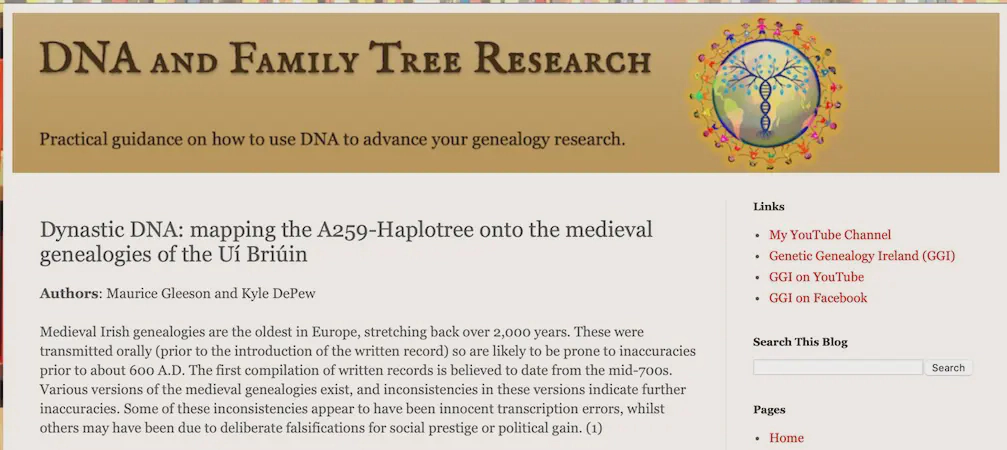
- Kevin McManus
- Dna
- July 31, 2024
Table of Contents
We are just writing to let you know that (after 4 years of effort) we have finally achieved publication of an article in Peritia, the Journal of the Medieval Academy of Ireland.
The article is aimed at medieval historians and is entitled Tracing the Sons of Brión. The R1b-A259 Y-DNA Subclade and the Uí Briúin Dynasty of Connacht.
The authors are ourselves (Maurice & Kyle), and Bart Jaski (one of the leading academic experts on the Irish medieval genealogies).

The paper assesses if the medieval genealogical record for the Uí Briúin dynasty of northwest Ireland is consistent with the ever-evolving R-A259 portion of the Y-Haplotree. The study uses data from over 350 SNP-tested individuals, including verified relatives (a half-brother, and a 3rd cousin once removed respectively) of the current chiefs of the O Conor Don clan and the Mac Dermot clan of Moylurg, both of which have extensive documented lineages that stretch back in time over 1000 years.
The McManus clan features prominently.
The study makes the following broad conclusions:
- In general, there appears to be good consistency between the medieval record and the genetic record. The three main branches of the Uí Briúin dynasty are represented by specific DNA markers:
a) Uí Briúin Ai by A259 > Y166841 … and A260 > FGC5939.2 … (see note 2) below) b) Uí Briúin Seola by A260 > BY11725 c) Uí Briúin Bréifne by A260 > BY3338 and A260 > A5902
The DNA signatures of the royal lineages of the O Conor Don and that of the Mac Dermot of Moylurg indicate that their genetic connection is inconsistent with what is documented in the medieval genealogies. This suggests that either the medieval genealogies contain a long-standing error (dating from medieval times), or a DNA switch has occurred at some point in one or the other lineage, but at this point we cannot say in which one, nor why. However, the first option seems more likely.
There are several notable exceptions where a surname appears to have been inaccurately attached to the genealogical record (e.g. O’Malley), and where prominent surnames in the genetic record do not correspond with their position in the genealogical record (e.g. O’Halloran, Mannion)
The study illustrates the usefulness of Y-DNA as a tool for researching medieval Irish genealogies and establishing which parts are likely to be accurate, and which parts are likely to be inaccurate or deliberately falsified. In addition, the methodology outlined in this study may serve as a useful template for future research in this area.
The e-version of the article is now available to download as a pay-per-view article. In addition, a free companion blog post summarising the key points of the article is available on the “DNA and Family Tree Research” blog (DNAFTR)
Here are the links:
Following discussions with Goran Runfeldt (Head of Research & Development at FTDNA), the latter blog post above will also appear (in two parts) on the FTDNA blog in the near future. Our study also spurred a re-assessment of the A259 portion of the Y-Haplotree by FTDNA, resulting in the following changes:
Following a T2T (telomere to telomere) re-evaluation, the problematic SNP BY11725 has now been added to FTDNA’s Y-Haplotrees, in addition to its newly-added sub-branches FTT167, FTT168, & FTT169. The associated TMRCA for each
SNP is as follows:
A260 > BY11725 … 563 CE (95% CI 231-837) … https://discover.familytreedna.com/y-dna/R-BY11725/scientific A260 > BY11725 > FTT167 … 810 CE (95% CI 414-1119) A260 > BY11725 > A10525 > FTT168 … 784 CE (95% CI 360-1114) A260 > BY11725 > A10525 > FTT168 > FTT169 … 813 CE (95% CI 311-1191) other FTT SNPs below A259 include: FTT166, FTT170, FTT172, FTT173, FTT174, & FTT175.
Other experimental FTT SNPs can be found here … https://isogg.org/wiki/FTT_SNP_index New “notable connections” relating to the A259 portion of the Y-Haplotree will be added in the near future. A new badge relating to the Uí Briúin will be available shortly. Project members who sit below A259 will receive this badge.
Hope this is of interest. Warm regards, Maurice & Kyle
Dr Maurice Gleeson MB
- Honorary Research Fellow
- University of Strathclyde
Kyle DePew
- Assistant Professor
- University of Alabama
Discuss on our Forums
Discuss this topic on the McManus Family History Forums